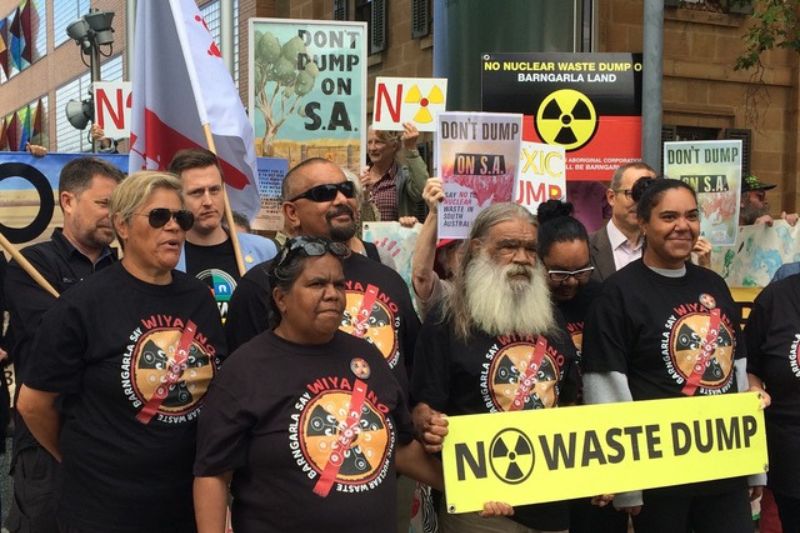On Monday 6 March, the Barngarla Determination Aboriginal Corporation (BDAC) began action in the Federal Court in Adelaide to overturn the federal Ministerial declaration to selecting Napandee near Kimba as the proposed site for a national nuclear waste facility.

The Barngarla people, the Traditional Owners of Kimba, have consistently opposed the controversial nuclear waste plan. The federal government has spent millions of dollars fighting the Barngarla in court, despite the continued efforts of the Barngarla people who do not want their sites and stories disturbed by a nuclear waste facility.
This fourth manifestation of federal governments of either persuasion to impose a national radioactive waste dump continues to be one of the best kept environment secrets in the country on all levels. There are still unanswered questions regarding the project itself, the actual necessity for it, and the risks involved.
Capitalising on the small amount of coverage South Australian affairs have in the media in general outside our own state, three out of the four chosen sites in this serial campaign since 1998 have been in South Australia. No coincidence either that the precedent seemed to be long set by SA being the main place of choice for the British nuclear explosions and the following so called 'minor trials' of the 1950s and 1960s.
'While appreciating the Labor government’s strong commitment to the Voice, the question remains as to why, at the same time, federal Labor are doing so much to continue the Coalition’s determination to silence the voice of the Barngarla.'
It may be worth again touching on the risks involved. Recently, a WA mining company lost a tiny radioactive capsule on the long southward trek down to Perth. Eureka Street readers may have heard as the story became international news. The authorities were certainly anxious that it be found, warning in the meantime how dangerous it would be to touch.

It seemed amazing that such a tiny entity could later be found in such vast territory of 1400 kms. Finding it was surely a classic triumph of the needle in the haystack success story. However, though certainly difficult, it was not impossible because of the radioactive rays it was emitting. Those of us concerned about the previous federal government‘s campaign to regularly transport, not a tiny capsule with a half life of 30 years, but long lived Intermediate Level radioactive waste — toxic for 10,000 years — have been regularly and understandably puzzled by the almost absent media coverage about this far more dangerous waste in the proposed regular 1700 km monthly transports from ANSTO Lucas Heights.
Regarding the actual necessity for the dump, the Coalition government has repeated the mantra about the ‘100 hospitals and universities throughout the nation housing radioactive waste’ as a prime reason for needing the national facility. Even normally reputable news outlets like the Guardian have been known to fall back on these easily-accessible Resource Ministers’ media statements providing inaccurate information.
The reality is in huge contrast to these claims. In October of last year, SA environmental expert David Noonan discovered, through reading the Australian Radioactive Waste Agency's own detailed information, compelling evidence that directly contradicted the claims of multiple government officials, department personnel, and ARWA staff.
Far from the claims that the proposed facility is ‘essential’ to prevent the nationwide ‘100 hospitals and universities’ being overwhelmed by the storage of nuclear medical waste products, Noonan’s research revealed the reality. Total Hospital existing and future LLW [low -level waste] is reported at only 3 m3 [three cubic metres]. Based on ARWA’s Report, all non-ANSTO sources produce on average only approx. 1.3 m3 per year of LLW over the next 100 years and produce approx. 1.34 m3 per year of Intermediate level waste ILW over the next 50 years.’ Not enough to necessitate the creation of a waste dump in Kimbra. In the words of environmentalists, ‘it’s ANSTO’s dump.’
Ignorance, (wilful or otherwise), by Parliamentarians about the matters of nuclear medicine is not confined to the Coalition. NSW Senator the Hon Tim Ayres was the presiding member for the absent Resources Minister, Madeleine King in the recent February Senate Estimates on these matters. Ayres' comments to SA Senator Barbara Pocock said it all: ‘But South Australians use X-rays. They use nuclear medicine. They use it for cancer treatments. They use it for all sorts of medical purposes’. When later conveyed to her, this statement drew the incredulity of Dr Margaret Beavis, GP and Co-Chair of ICAN Australia, and Vice-President Medical Association for Prevention of War. As Dr Beavis explains: ‘Nuclear medicine is used for medical imaging and to treat some cancers. Nuclear medicine should not be confused with X-rays, CT scans, MRIs, radiotherapy or chemotherapy, which are much more commonly used.’
The previous November Senate Estimates seemed to give Shaun Jenkinson CEO of Australian Nuclear Scientific and Technology Organisation (ANSTO) an almost uncritical forum for propagating ANSTO’s claims of the Kimba dump being essential for the survival of Australia’s nuclear medicine, even when challenged by the new SA Senator, economist Professor Barbara Pocock. In February’s recent Senate Estimates, Senator Barbara Pocock asked what contingency plans were in place to produce and store nuclear medicine if the facility didn't go ahead at Kimba. Jenkinson’s response was measured, admitting that there is room at ANSTO. 'We continually look at the storage capacity on site, and we of course look at the projected time for the national radioactive waste management facility. We work closely with ARWA, and, if there was to be a delay in that, we would be seeking approval for additional onsite storage until such time as a national radioactive waste management facility was ready.'

Cost has been, and is, no obstacle to either federal government to ensure their project goes ahead. As the recent BDAC briefing paper reveals, 'since 1 January 2017, the Commonwealth Government has spent close to $10 million on legal work for the nuclear waste dump and the AWRA (Australian Radioactive Waste Agency).' In the last year alone, the Commonwealth Government spent around $2 million, or approximately $40,000 every week, on a team of 14 lawyers to fight the Barngarla in court. Norman Waterhouse, the legal firm representing the Barngarla people, and the legal team working with Norman Waterhouse have endured all of the Commonwealth's litigation for fees of $500K in 2022. The Barngarla’s legal team has withstood tremendous pressure from the Commonwealth lawyers for a quarter of the cost to take the case.
While appreciating the Labor government’s strong commitment to the Voice, the question remains as to why, at the same time, federal Labor are doing so much to continue the Coalition’s determination to silence the voice of the Barngarla.
Michele Madigan is a Sister of St Joseph who has spent over 40 years working with Aboriginal people in remote areas of SA, in Adelaide and in country SA. Her work has included advocacy and support for senior Aboriginal women of Coober Pedy in their successful 1998-2004 campaign against the proposed national radioactive dump.
Main image: Barngarla Traditional Owners and supporters outside the Federal Court Adelaide, 6 March. (Jim Green)